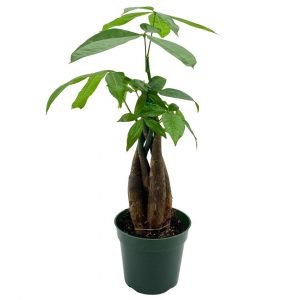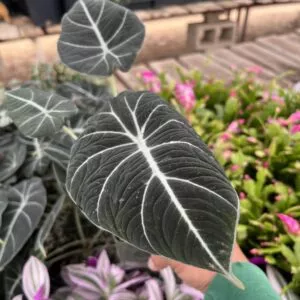No products in the cart.
Table of Contents
Have you thought that maintaining bonsai trees are impossible? Maybe you think the art of bonsai is not for you. Think again! You are presuming wrong.
The truth is that most bonsai trees are easy to care for. You do not need previous experience if you do decide to get yourself a bonsai tree.
But what tree species should you invest your time in? We are here to help answer that question.
Types of Bonsai Trees
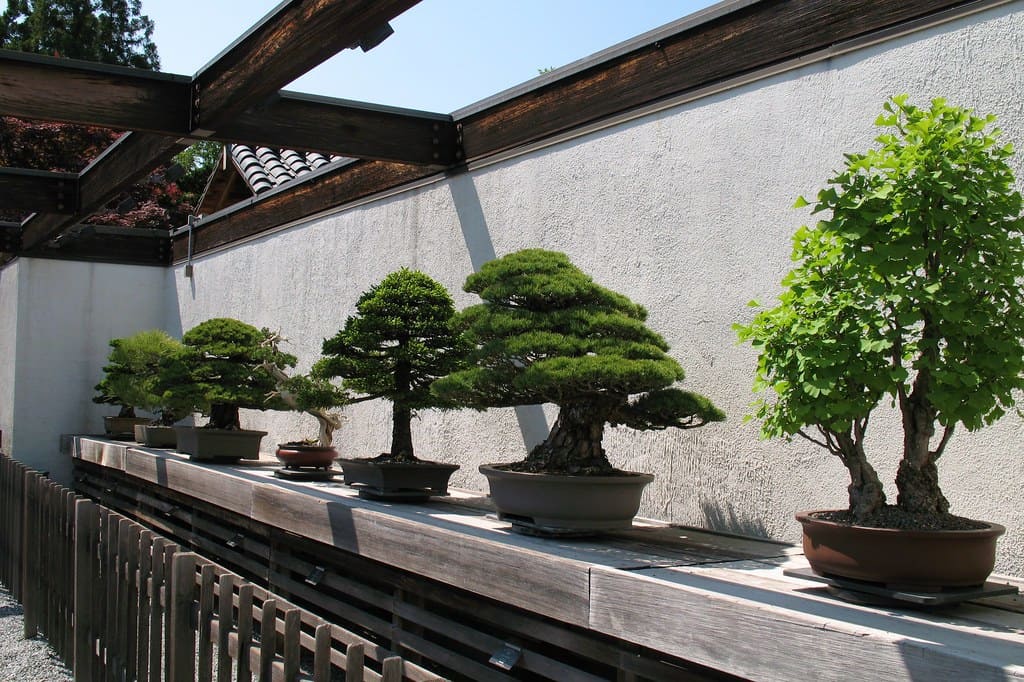
When choosing from the different types of bonsai trees, the first thing to consider is whether you are new to the art or already a novice at it.
If you are a beginner, it helps to get a bonsai tree that is easy to maintain. Doing this allows you to see how your tree species behave, grow, and how you will get along with them.
Also, consider the climate you live in. If it is very cold or hot, it determines the kind of tree you should get.
Still, consider your budget and what you can afford. You can find bonsai trees that are rare and costly.
So, to take full advantage of the art of caring for your bonsai trees, choose an affordable option with low maintenance as a beginner.
Beginner Bonsai Trees
Plantly have a list of some of the most beautiful outdoor bonsai trees you can care for in your home.
Ficus Bonsai Trees
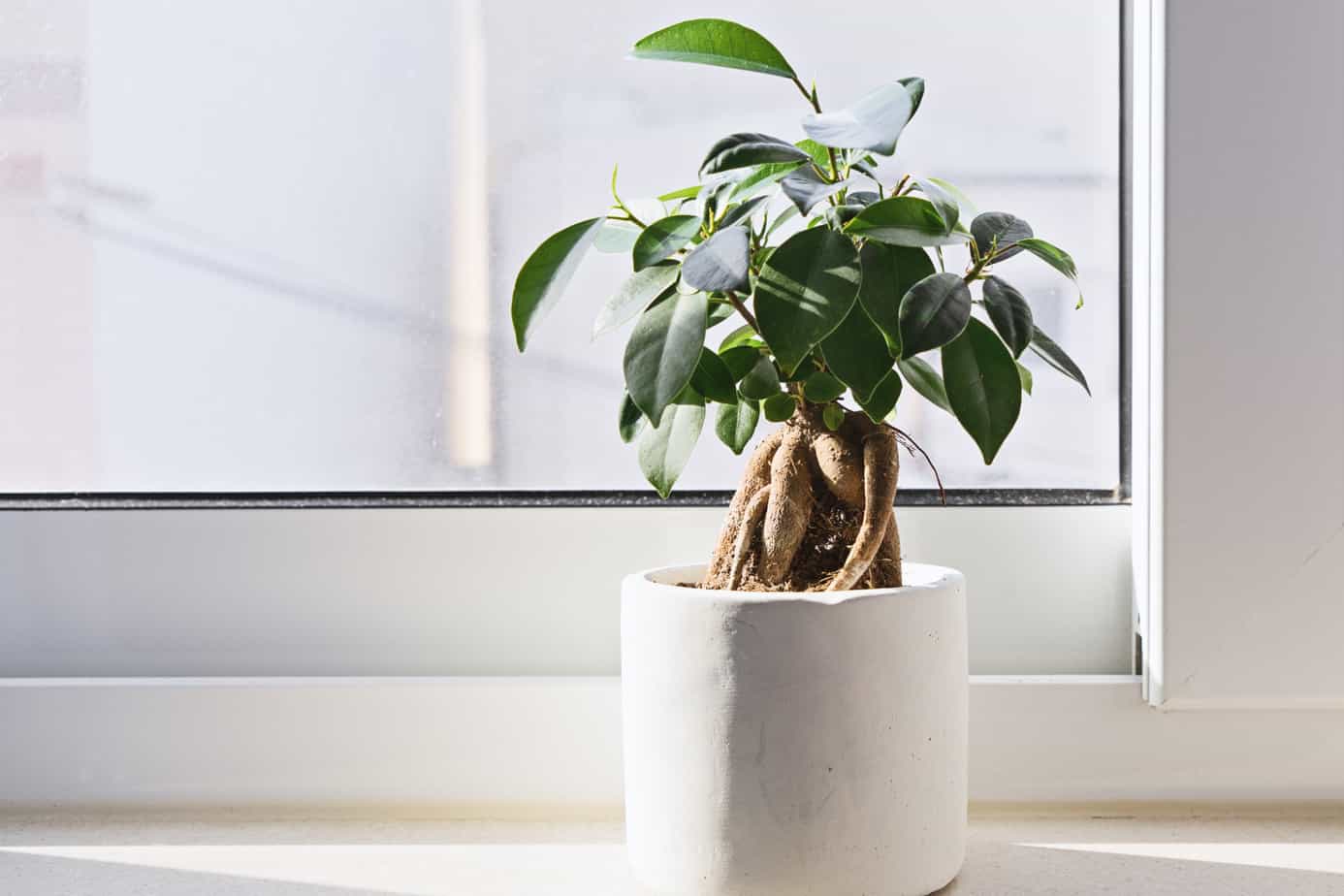
A ficus bonsai tree is an excellent option for beginners to use as an indoor bonsai tree. But you can find more than 850 varieties available. The popular ficus trees are:
- Ficus Mactrophylla
- Ficus Benjamina
- Ficus Retusa Microcarpa
- Ginseng or Retusa
The Ginseng is an excellent option for beginners with its s-curved trunk to prune, and the majority of these trees respond well even with restricted growth.
These trees are not outdoor bonsai trees and are mostly grown indoors. They thrive in sunlight and warm temperatures. The best part is that they forgive you when you make mistakes.
Japanese Maple Bonsai Tree
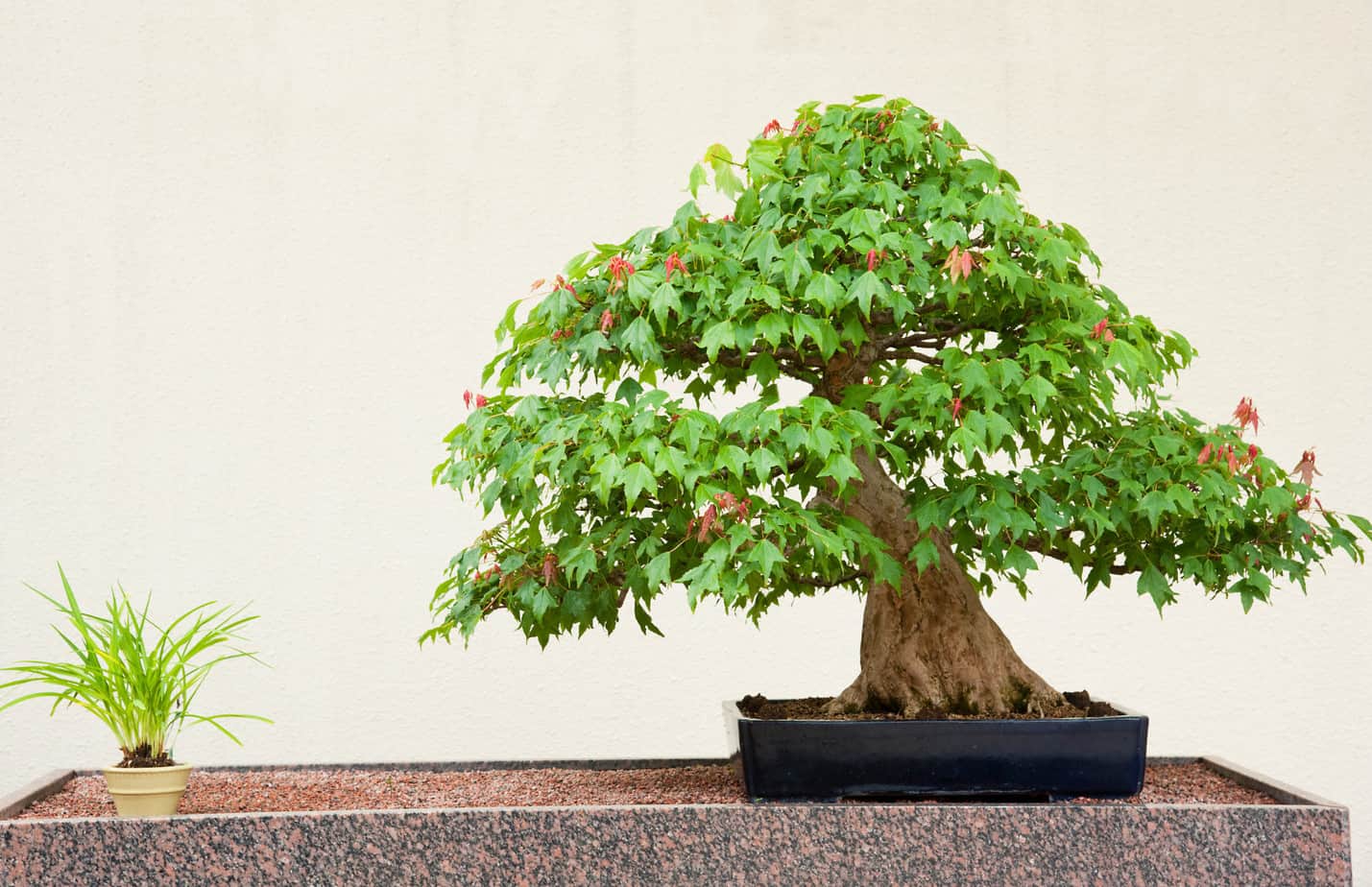
For the newbie gardener, the Japanese maple bonsai tree is a great plant to have. Not only is it easy to care for beauty during fall. In addition, your tree displays hues of orange, red, or yellow to brighten up any living space with color and energy.
The Japanese maple bonsai tree comes highly recommended for beginners and advanced enthusiasts. It is one of the most accessible bonsai trees to look after without much effort when it comes to maintenance or care.
Another great thing is this tree is happy to grow in shaded spots in scorching climates. But you need to take care of overwatering as it can affect growth. Still, it is also an outdoor bonsai tree and loves the sun in cooler climates that are airy.
Juniper Bonsai Trees
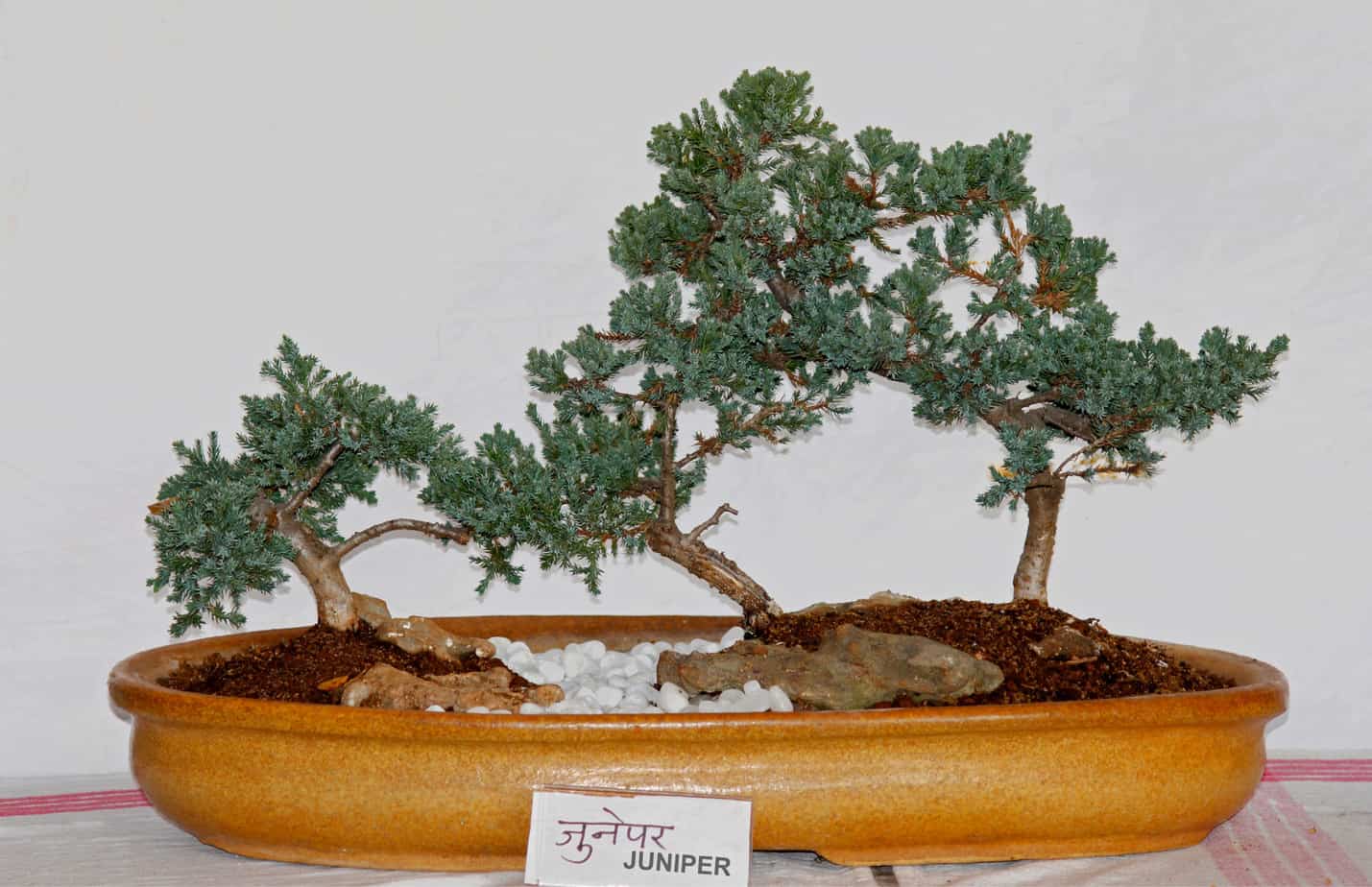
Another simple type of bonsai tree is the Juniper which is easy to maintain. The tree is hardy even if you forget to water them for a day or two. The branches are flexible and shapes into any form. Some popular Juniper bonsai trees in the species are:
- The Green Mound Juniper Bonsai
The tree is trendy and thrives in most climates while being easy to maintain. Trimming the foliage is a breeze for beginners, and they even thrive outdoors but need protection from the sun.
- Needle Juniper Bonsai Tree
The Himalayan Juniper is a lovely tree bringing loads of peace to any household. Shaping the tree and caring for it is easy.
Chinese Elm Bonsai Tree
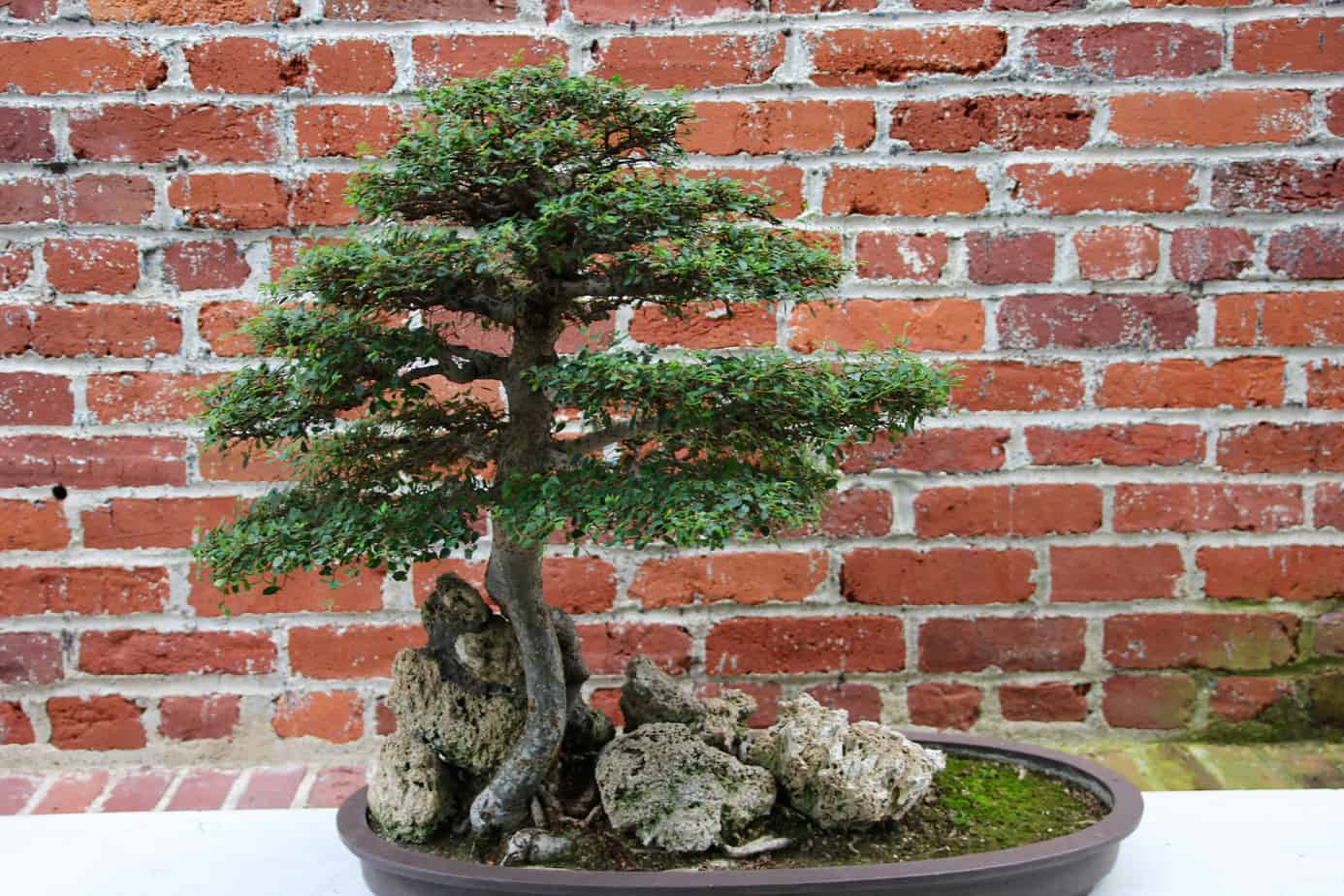
The Chinese elm is an attractive bonsai tree for newbies. It has a twisting trunk with tiny leaves. The trunk is strong, and the structure is pleasing to the eye. The delicate branches give an exotic touch to any indoor space.
The Chinese elm bonsai tree also has a mild temper for beginners and is easy to care for. The tree grows well in warm climates but does not tolerate cold. But when you nurture them properly, you get joy out of them and remain green all year round.
Bougainvillea Bonsai Tree
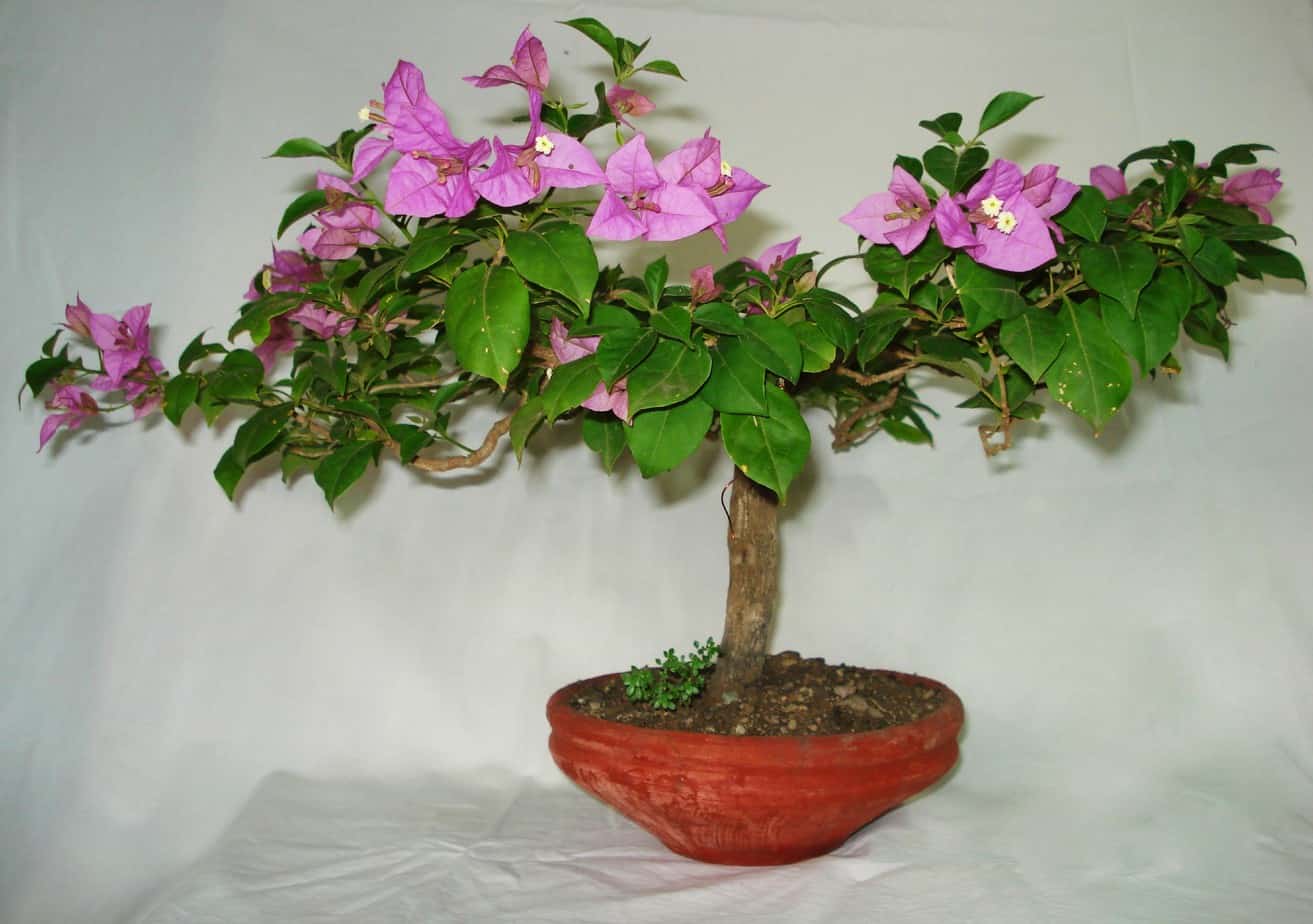
Just look at the gorgeous purple-pink flowers on this tree species. Interestingly enough, it is not flowers but leaves found on this evergreen bonsai tree. The flowers of the Bougainvillea grow small and yellow.
It is a tropical evergreen that beautifies any place, but it has thorns in shades of white, red, pink, orange, or even double shades. Maintaining the tree is easy to style into different shapes.
The Bougainvillea is an outdoor bonsai tree that loves direct sunlight and heat. Yet, it would be best to water them when the soil is dry as they do not enjoy wet feet. To prune the bonsai tree, you need to remove the shoots after they flower.
To twist the plant, you need to train your tree when young as your older plants will get hard and break. Still, keep an eye on those sharp thorns when you do the wiring.
Azalea Bonsai Tree
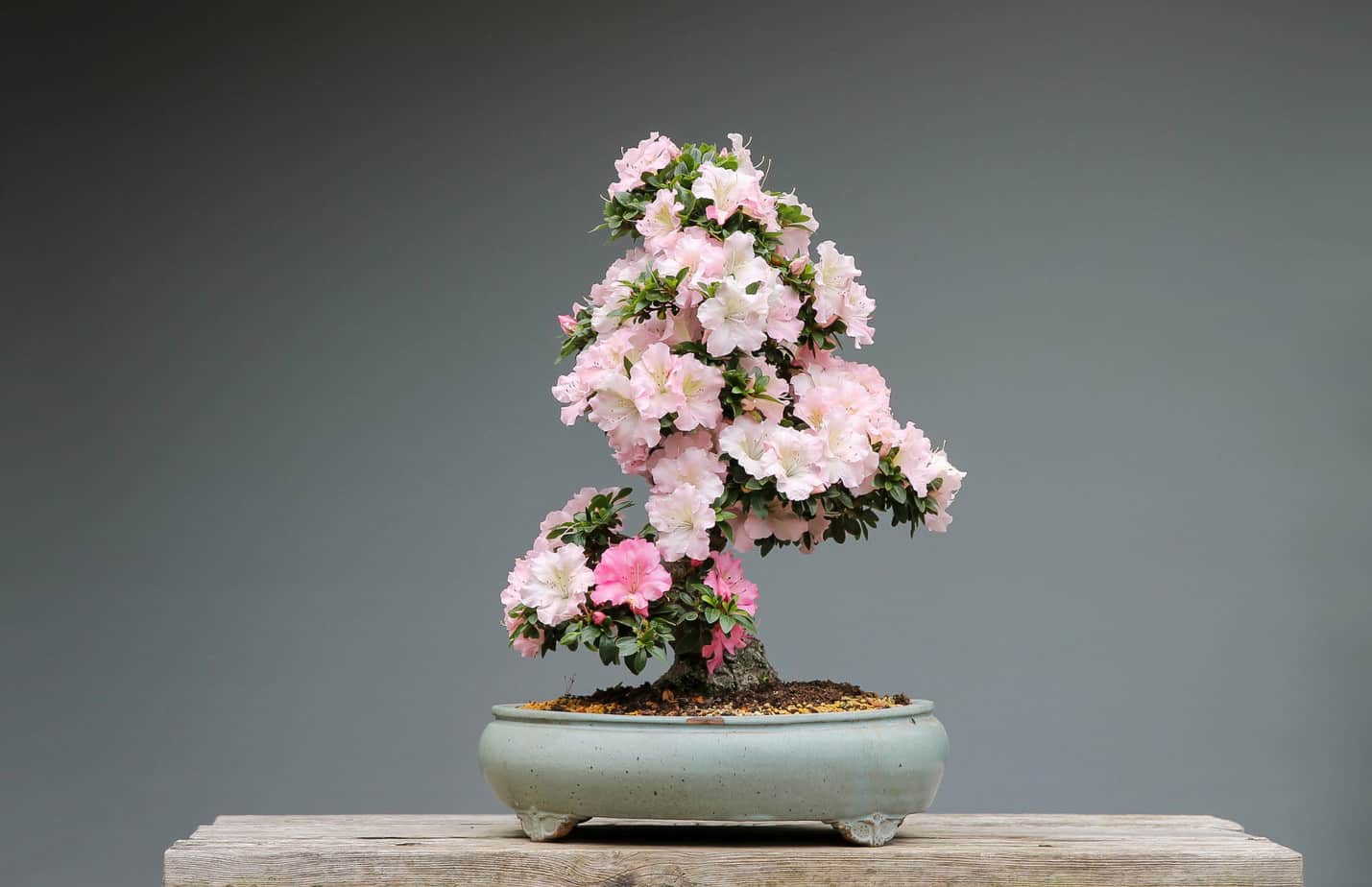
The bonsai tree is one of the most attractive flowering bonsais you can find. Azalea bonsai tree adds ornamental value to any living space and decor. There are more than 1000 species in the Rhododendron genus.
But the popular ones are the Kurume and Satsuki Azalea to grow as bonsai trees. It is a rare tree that produces showy red, white, to pink flowers. It is an outdoor type of bonsai tree that flourishes in bright sunlight.
Still, they cannot handle extreme heat, and best to keep them in shady spots in summer. You also need to water them regularly to prevent the soil from drying out completely. But overwatering is not advised, and they need pruning done on the lower parts to form the shape.
Hibiscus Bonsai Tree
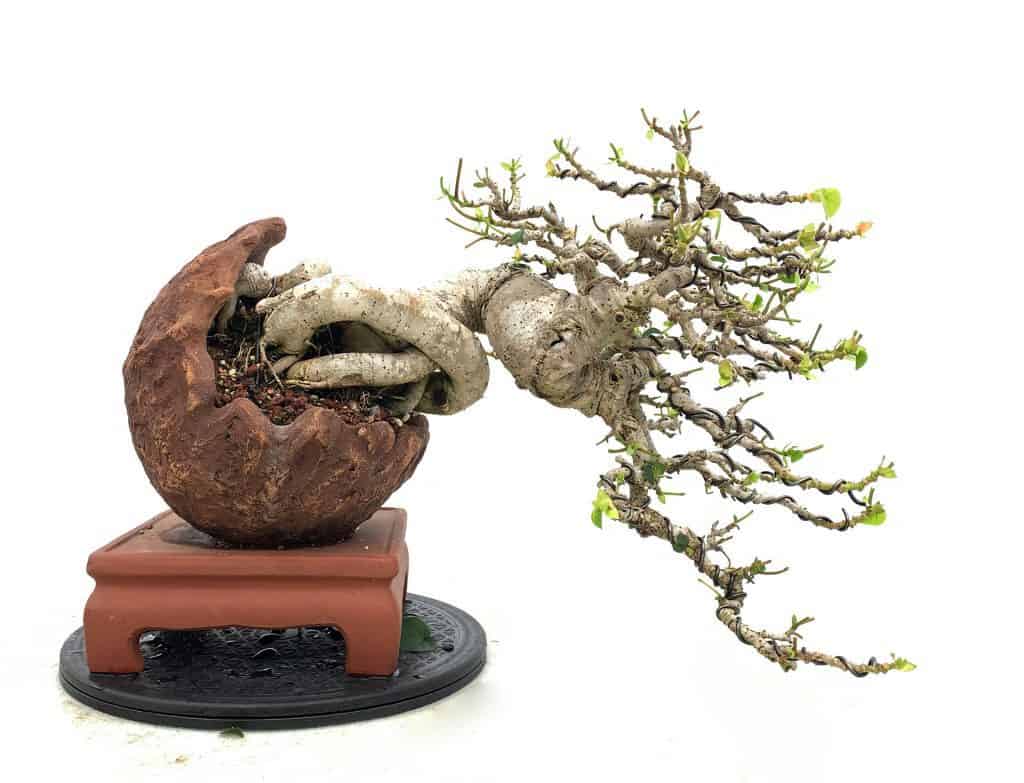
Another attractive bonsai species that bloom beautiful flowers is the Hibiscus bonsai tree. It is a tropical shrub that thrives in warm climates. You can find many varieties of this shrub that produces flowers in different shades and sizes.
Another appealing thing about the Hibiscus bonsai trees is the glossy green foliage with vibrant flowers. As an indoor bonsai tree, it prefers a well-lit spot on the balcony or near a window.
These bonsai trees do not do well in cold or frost conditions and, if treated as an outdoor plant in summer, provides it with an airy shady spot. Also, keep the soil moist, and add some bi-weekly feeds of fertilizer to keep it healthy.
Oak Bonsai Tree
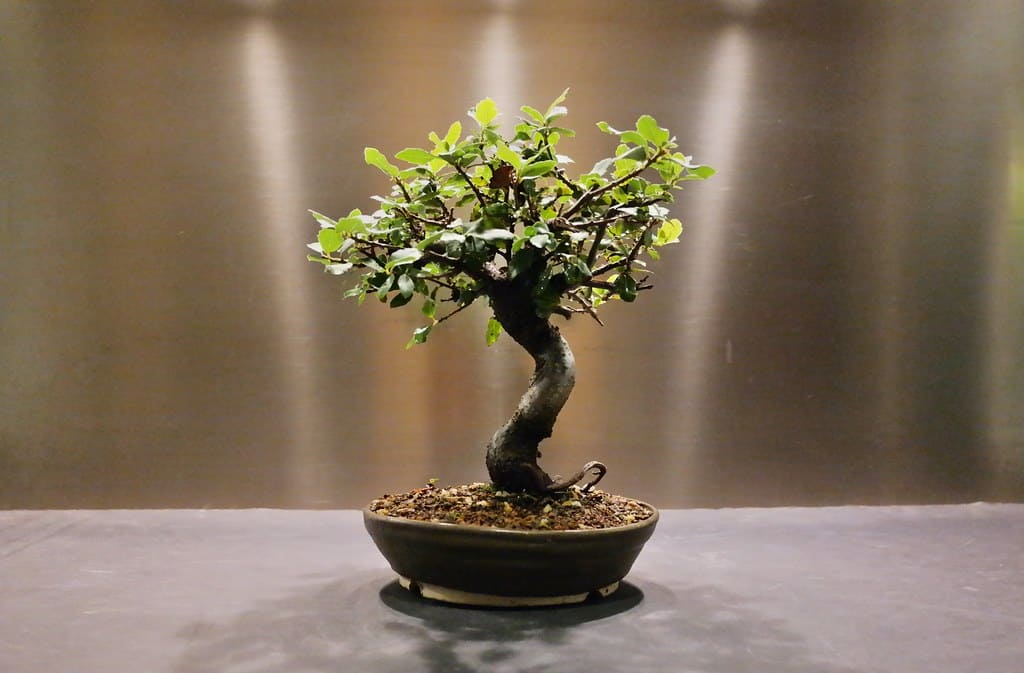
Indoor bonsai tree types like the Oak Tree species can effortlessly grow even if bonsai enthusiasts say it’s not. The tree is magical, and they are resistant to various climates. While the oak bonsai tree loves sunny spots, they also need regular watering in summer.
Depending on your oak, it can be an evergreen or deciduous tree growing up to 40 feet tall in its natural habitat. The tree species is hardy with strong trunks producing small acorn fruits. With its zigzag structure as a bonsai tree, it looks like a piece of art.
To encourage healthy foliage, you will need to prune the leaves and the terminal buds.
Ginkgo Bonsai Tree
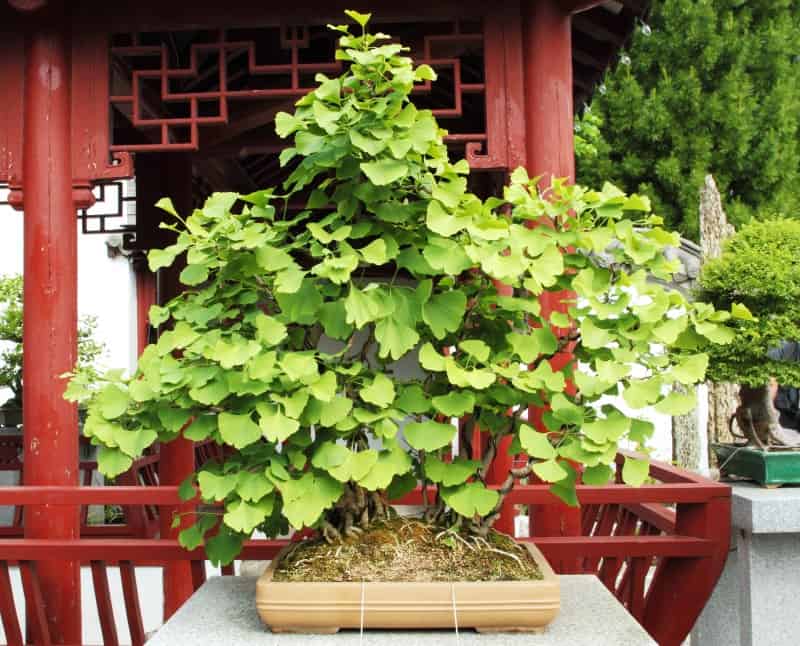
The deciduous trees you identify with their fan-shaped leaves. It is one of the oldest bonsai tree types. You can find the bonsai species in both male and female varieties. The female bears fruit with an unpleasant odor, while the males do not produce any fruit.
In Chinese medicine, they use leaves for treating different ailments. The tree thrives in direct sunlight but does not respond well to frost. Yet, they need regular watering but not overwatering.
Gingko is an exceptional beginner indoor bonsai tree for its flexible and cooperative branches when wiring.
Crabapple Bonsai Tree
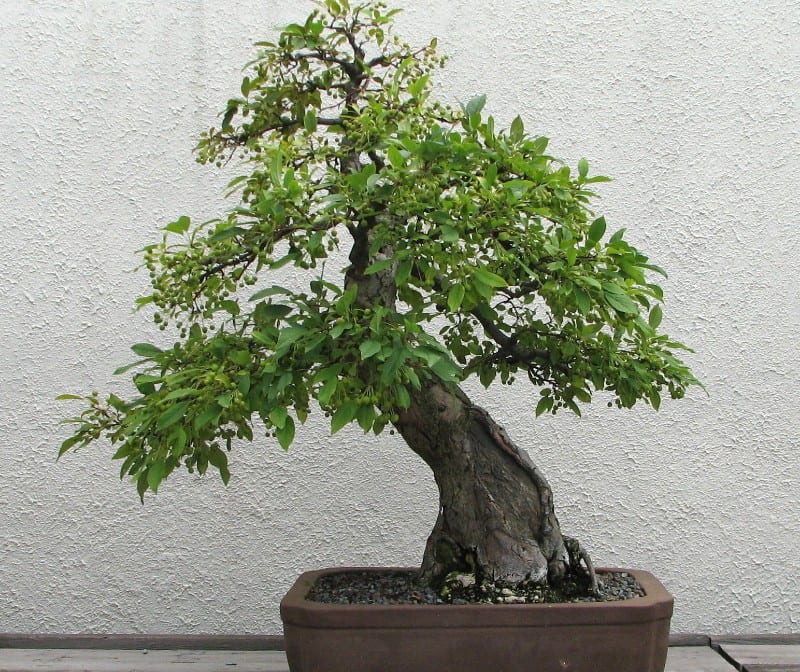
Okay, while the crabapple bonsai tree produces an apple, it is small with a tart taste than your usual apples. It is also a deciduous bonsai prized for its white-pinkish flowers with small fruits during harvest season.
The tree species needs airy and direct sunlight to flourish, but move your indoor bonsai tree to a shadier spot when hot. Your miniature trees need regular watering as the fruits will drop if the soils dry.
Also, pruning needs to be done after the leaves fall in late autumn, and you can re-pot your tree annually when young.
Pomegranate Bonsai Tree
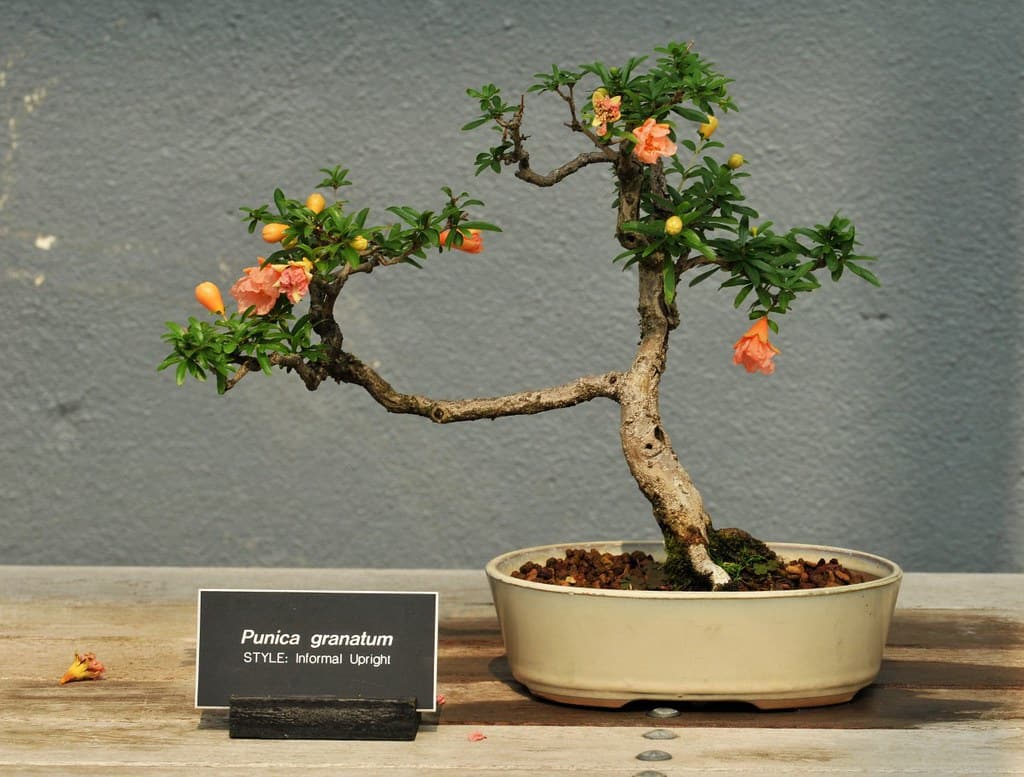
Pomegranate is another deciduous tree with large fruits that you can eat. In the variety, you find different species like:
- Punica Gratanum
- Dwarf Pomegranate Bonsai Tree
The Nana or dwarf pomegranate bonsai trees produce small fruit, and then you find one the Nejikan that is more for ornamental display. The trees need warmth to grow with regular watering during the flowering season.
The best time to prune and wire is when you notice the leaves are falling off, and the branches are bare in the shedding season.
Cedar Bonsai Tree
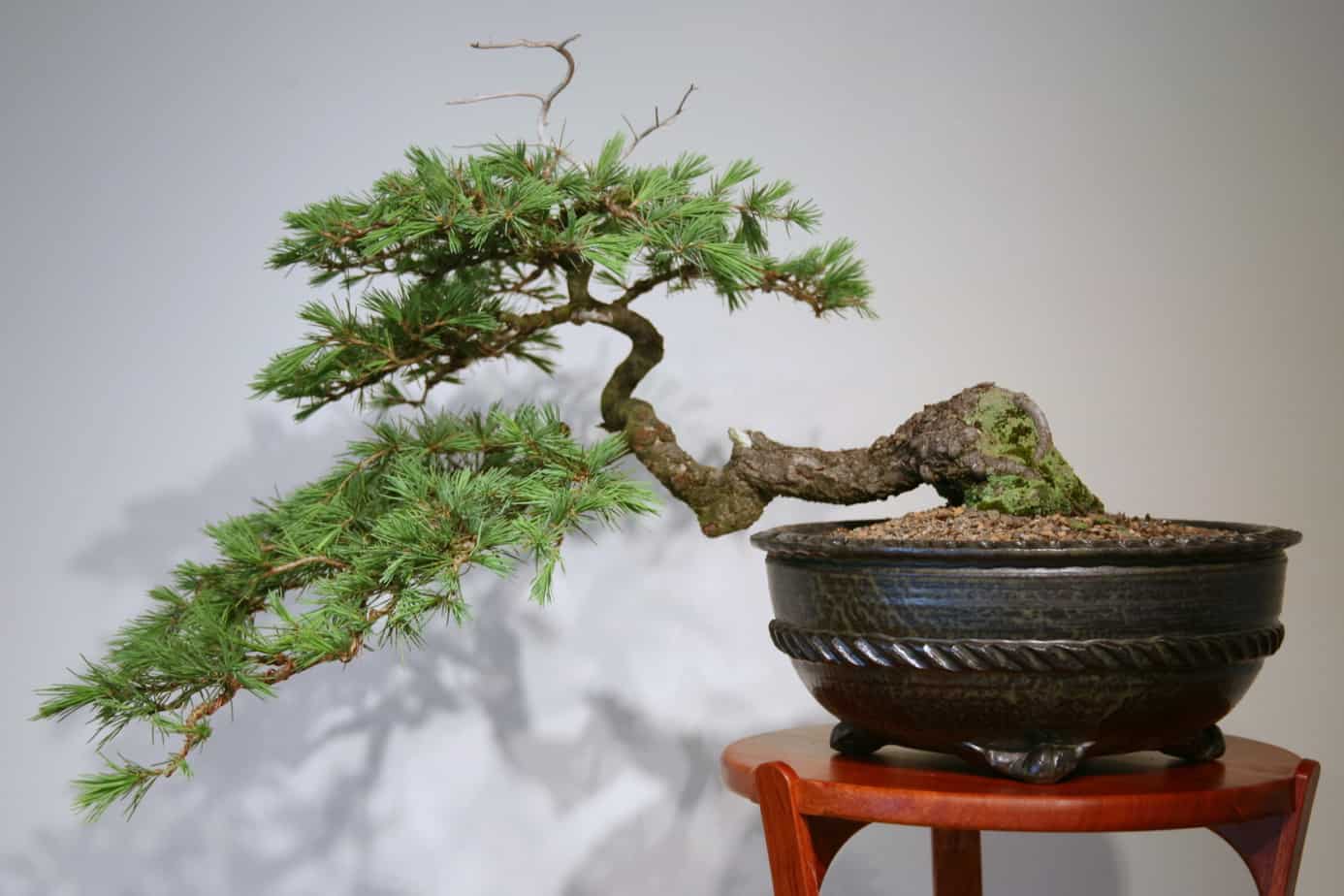
Cedar trees are a good choice if you want a bonsai tree that grows tall but remains a miniature tree. Many botanists call this the Cedrus and need regular watering with a sunny spot indoors.
The Himalayan Cedar bonsai tree is a popular plant with a lot of ornamental value and grows up to 50 feet in its natural habitat. The evergreen has short leaves like pine needles with a dark green to bluish tint.
The Cedar makes for exceptional indoor bonsai trees in well-ventilated areas. The Cedar bonsai trees need minimal water, and overwatering them leads to brown leaves. The trunk needs pruning along with the leaves to help create various styles.
Advanced Bonsai Tree Species Growers
Now that we have covered some beginner bonsai trees, let’s look at indoor bonsai trees for the more advanced grower.
Weeping Willow Bonsai Tree

The weeping willow is another excellent tree for beginners to maintain. The tree is native to China, but you do find them growing across the globe.
The willow is an exciting plant you can add to your bonsai collection, with its long weeping branches giving it loads of character. Still, the growth habit makes it challenging to prune for beginners and is a better option for advanced growers of bonsai tree species.
-
Free Shipping$39.97Sold By: Grow Your Own Food Nursery
In stock
River Tamarind Miracle Tree Plant
Sold By: Grow Your Own Food Nursery -
$12.99Sold By: BubbleBlooms
In stock
Watermelon Pilea Cadierei, Aluminum Plant, 4 inch
Rated 4.81 out of 5 based on 279 customer ratings00Sold By: BubbleBlooms -
$22.99Sold By: BubbleBlooms
In stock
Money Tree, Pachira aquatica, water chestnut, very large bonsai plant, Perfect Houseplant, Guiana Malabar, in a 4 inch pot ready for 6 inch
Rated 4.81 out of 5 based on 279 customer ratings00Sold By: BubbleBlooms -
$15.00Sold By: Cacti and Exotica
In stock
Alocasia Black Velvet
Only 10 available and it’s in 4 people’s basketRated 4.98 out of 5 based on 59 customer ratings00Sold By: Cacti and Exotica
Buddhist Pine Bonsai Tree
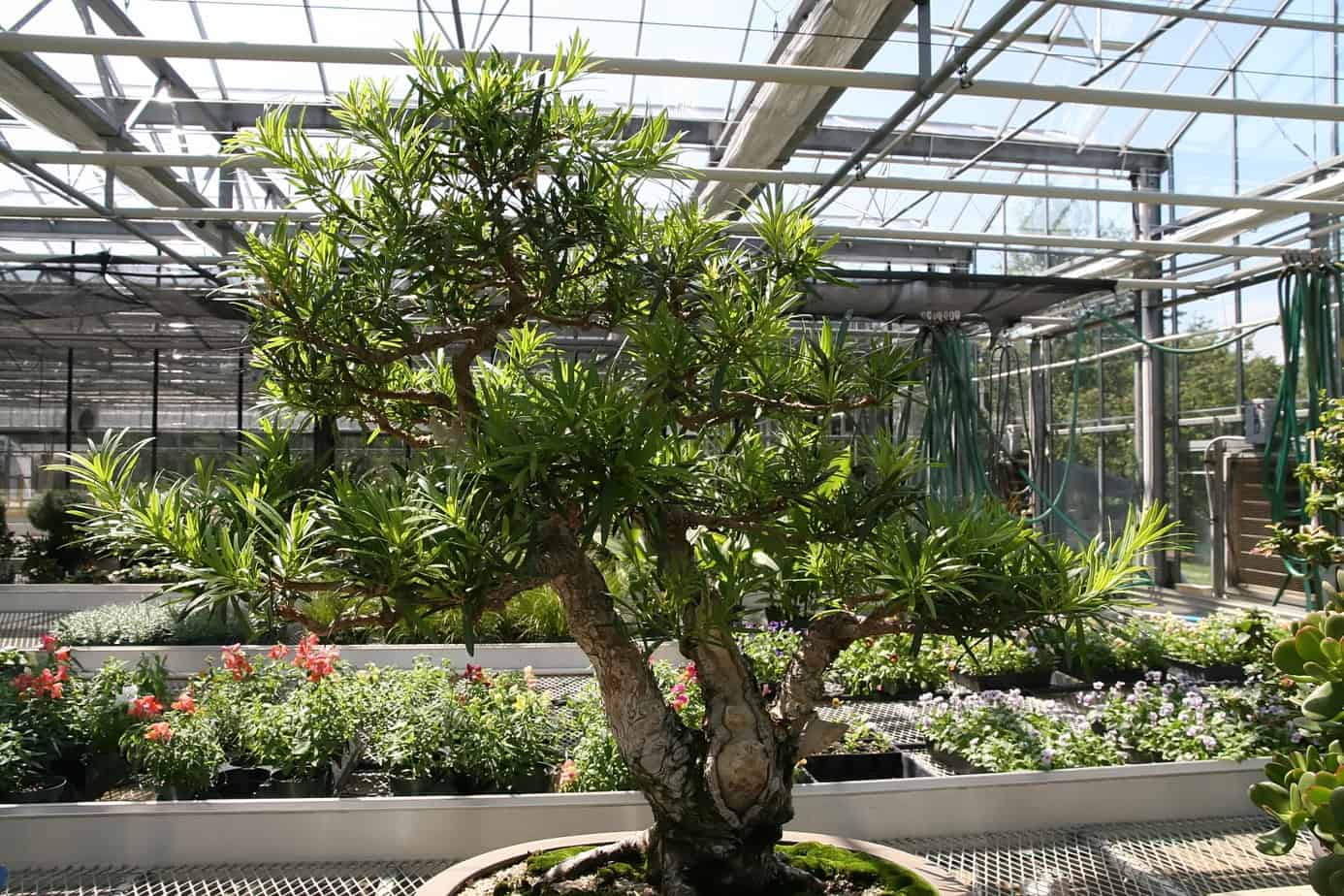
One of the popular bonsai tree types is the pine tree. While they offer excellent shade and ornamental value outdoors, it is not beginner bonsai tree as it has a complex nature. The evergreen bonsai trees grow cones and needles.
There are over 120 species, and as popular as the Buddhist pine, you also get the following:
- Japanese White Pine
- Japanese Black Pine
The trees need full sun and only need watering when the soils dry. You also need to remove the candles regularly to encourage the growth of the smaller needles. Finally, after pruning, the wiring you do to shape it into the desired form.
Pine is the hardest to care for because of the growth pattern of all types of bonsai trees. The tree does not effortlessly turn into a bonsai tree species.
Black Olive Bonsai Tree

The olive is an evergreen tree, and the black olive bonsai tree is one of them. The tree has short leaves with slow growth and grows from yellow flowers. It belongs to the outdoor types of bonsai trees.
Hence, it needs full sun and can withstand cold temperatures but not frost. You need to water these bonsai trees regularly but never overwater them. The soil needs to drain well to prevent root rot.
The tricky part is to wire the tree as it matures as the bark gets hard. You can prune your bonsai tree in winter for better growth.
Bonsai Money Tree
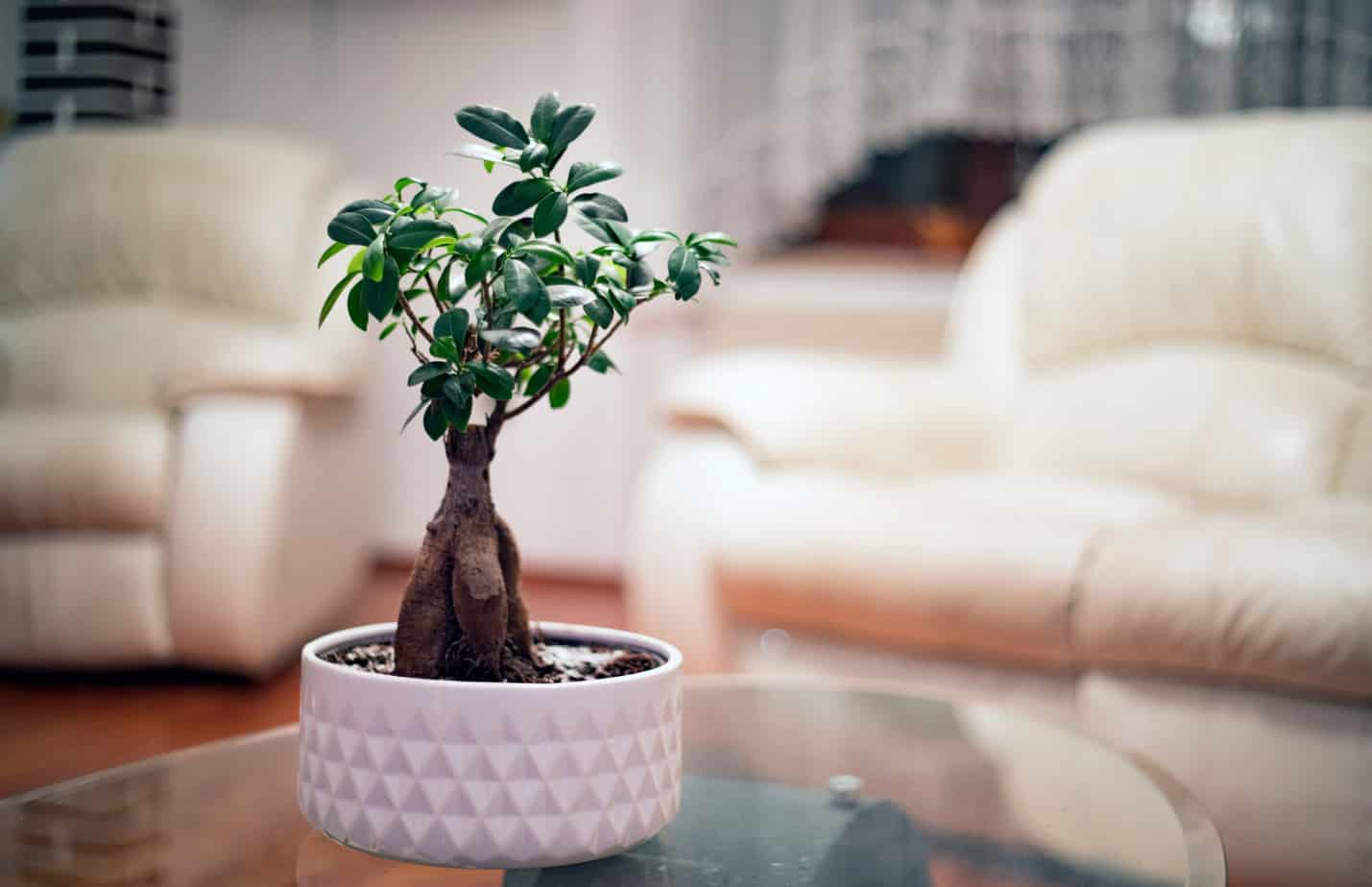
The bonsai money tree is a popular bonsai tree with broad leaves that can grow up to 65 feet tall. In addition, the tree has a swollen trunk where it stores water.
The biggest challenge with these bonsai tree types is it does not produce natural branches, and as it ages, the tree trunk braids, crushing one another in the process.
The tree needs a well-ventilated spot with high humidity and prunes in winter for healthy growth. The tricky part comes with wiring as the bark damages easily.
Where to buy Bonsai trees?
When investing your time in the bonsai tree art form, you can find the mentioned tree species at a local garden center or online. Still, you need not go hunting for one online as Plantly has a selection of bonsai trees available for you to buy.
The best part is that you need not leave your home’s comfort and can have your bonsai tree delivered to your door.
Pick the Best Bonsai Tree For You
Each of the bonsai trees on the list has gorgeous facades and will make a great addition to your living space. Cultivating a bonsai tree offers you a wide range of mental and physical benefits, but most importantly, it helps you practice mindfulness.
Also, continue to learn about how to care for your bonsai trees with Plantly’s step-by-step guide.
Whether you want to buy, sell or simply reach out to other plant enthusiasts, Plantly is the right place to be!


